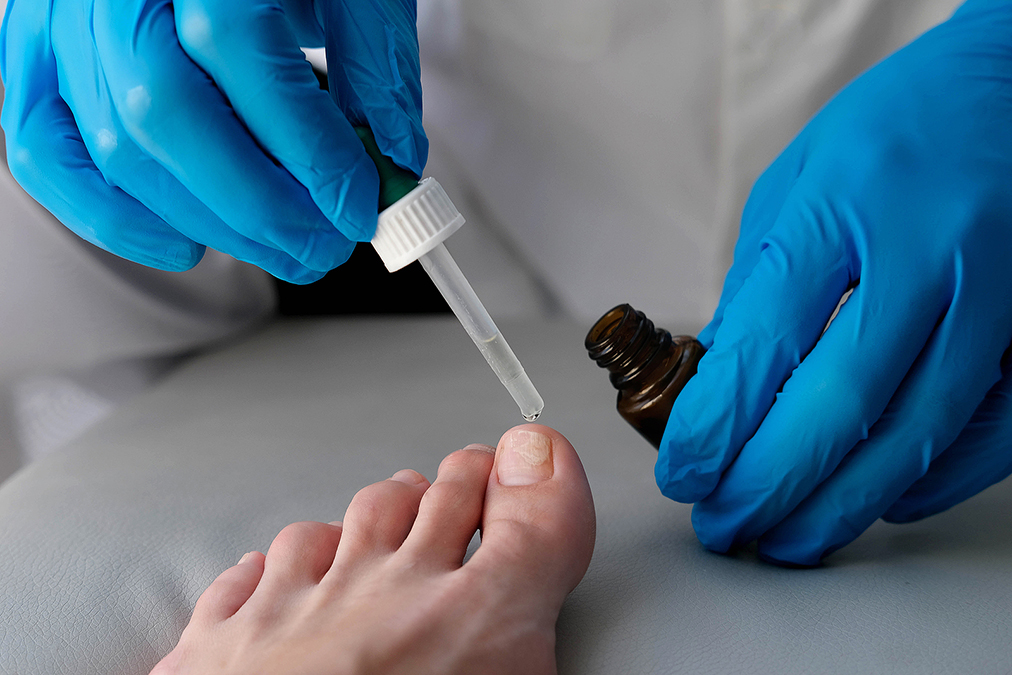 Nail fungus is notoriously difficult to treat with topical ointments. The reason is that once the nail fungi take hold, they organize in biofilm.
Nail fungus is notoriously difficult to treat with topical ointments. The reason is that once the nail fungi take hold, they organize in biofilm.
Biofilm is like a thick and robust armor of viscous fluid that is filled with microorganisms like fungi that stick to a solid surface like nails. This armor prevents topical ointments from reaching the fungi and killing it.
Strangely, no study or topical fungi ointments has taken this into account.
Until now, that is.
A new study in the journal Microbial Pathogenesis compared the usefulness (or lack of) of various topical ointments, and found one natural substance that breaks through the armor of biofilm, therefore eliminating nail fungus more effectively than any of the chemicals used in the past.
Propolis is a sticky green-brown glue that bees produce from tree buds and sap after mixing these with their beeswax, honey, and digestive enzymes.
They coat the inside of their hives with it and plug leaks with it. Because it is such an incredibly strong anti-bacterial and antifungal substance, it keeps the hives free of these microorganisms and thereby keeps the bees healthy.
Because propolis has such potent antifungal properties, the authors conclude that it is the best candidate for penetrating the fungal biofilm.
The only problem? Although there is some research that backs its use for nail fungus, the studies are rather small.
In 2018, for example, researchers applied it to the nails of four elderly people, achieving complete resolution in two cases and 70–80% resolution of the infection in the other two.
Another study in 2018 achieved complete resolution in 56.25% of their subjects and incomplete but good resolution in the rest. They specifically verified that propolis could penetrate the nail and the biofilm.

 Overcoming IBD
Overcoming IBD Multiple Sclerosis
Multiple Sclerosis Banishing Bronchitis
Banishing Bronchitis Gum Disease Gone
Gum Disease Gone Overcoming Onychomycosis
Overcoming Onychomycosis Neuropathy No More
Neuropathy No More The Prostate Protocol
The Prostate Protocol Brain Booster
Brain Booster
 Ironbound
Ironbound
 Solution for Shingles
Solution for Shingles
 The Bone Density Solution
The Bone Density Solution
 The Ultimate Healing Protocol
The Ultimate Healing Protocol
 The Parkinson's Protocol
The Parkinson's Protocol
 The Chronic Kidney Disease Solution
The Chronic Kidney Disease Solution
 Overthrowing Anxiety
Overthrowing Anxiety The Fatty Liver Solution
The Fatty Liver Solution The Hypothyroidism Solution
The Hypothyroidism Solution
 The End of Gout
The End of Gout The Blood Pressure Program
The Blood Pressure Program
 The Oxigized Cholesterol Strategy
The Oxigized Cholesterol Strategy
 Stop Snoring And Sleep Apnea Program
Stop Snoring And Sleep Apnea Program
 The Arthritis Strategy
The Arthritis Strategy The Vertigo & Dizziness Program
The Vertigo & Dizziness Program The 3-Step Diabetes Strategy
The 3-Step Diabetes Strategy Hemorrhoids Healing Protocol
Hemorrhoids Healing Protocol The Erectile Dysfunction Master
The Erectile Dysfunction Master Weight Loss Breeze
Weight Loss Breeze The IBS Program
The IBS Program The Insomnia Program
The Insomnia Program The Migraine and Headache Program
The Migraine and Headache Program The Neck Pain Solution
The Neck Pain Solution The Menopause Solution
The Menopause Solution The Ejaculation Master
The Ejaculation Master The TMJ Solution
The TMJ Solution The Acid Reflux Solution
The Acid Reflux Solution The Fibromyalgia Solution
The Fibromyalgia Solution The Psoriasis Strategy
The Psoriasis Strategy